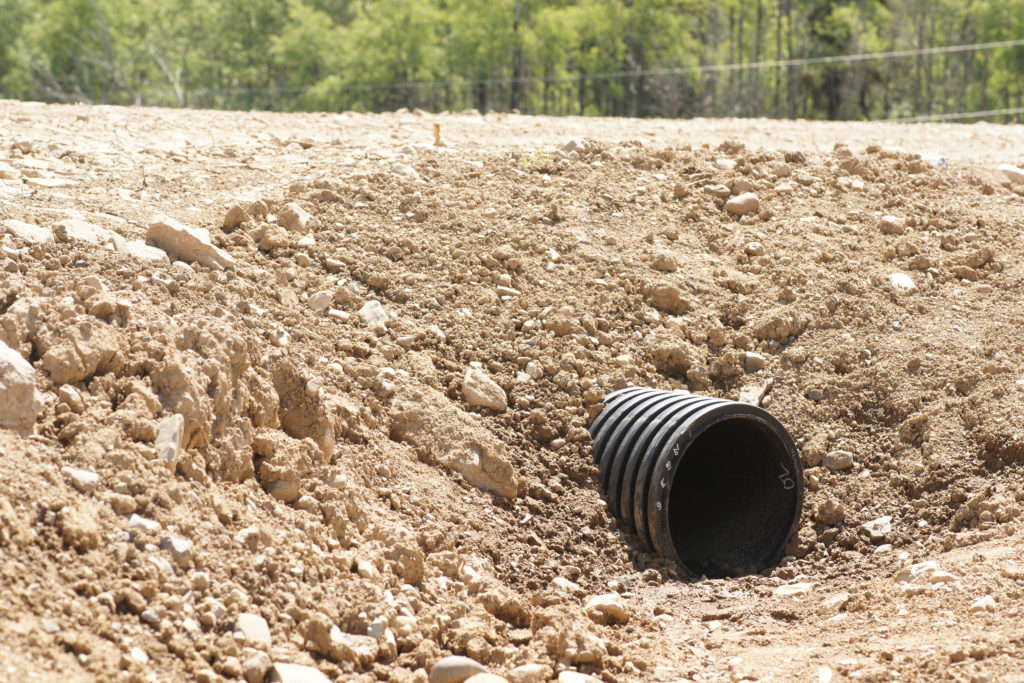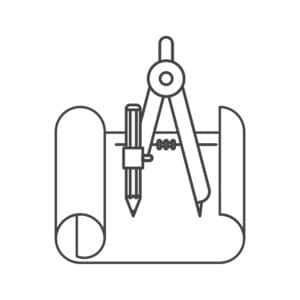A culvert in simple terms is a structure that is designed to carry stormwater drainage or existing waterway flow from one side of a road, driveway, or pedestrian walkway to the other side. The main goal of a culvert is to prevent the overtopping of the road, driveway, or pedestrian walkway during certain rainfall events.
There are many things to consider in a culvert design. This post will discuss on a general level what is involved with a typical design and what steps are required.
Where a Culvert Is Used
The following are some examples of locations where culverts are commonly used.
1) Over an existing creek or stream – The construction of a new road over an existing creek would require the design a culvert or a set of culverts to maintain the existing flow of the creek. This assumes that the drainage area for the creek is small enough for a culvert design to be applicable. For major creeks and rivers that have very large drainage areas, the construction of a bridge might start to make more sense.
2) At a proposed driveway entrance location with an existing roadside swale – The crossing of an existing swale by a new driveway is similar to the crossing of a new road over a creek and would also most likely require the design of a culvert to maintain existing drainage patterns.
3) At natural drainage low points along a proposed walking trail – If you are proposing a long walking trail through an area that has a lot of varying terrain with existing drainage waterways to be crossed by the proposed trail, a culvert might have to be designed at these crossings.
Advertisement
Culvert Materials
Culverts can be made of different materials that can vary in cost. The most common culvert materials are corrugated metal, high-density polyethylene plastic, and reinforced concrete. Which material is chosen could be based on the budget of the builder as well as the requirements of the reviewing municipality.
Culvert Shapes and Sizes
The shapes of culverts can also vary. Circular pipe culverts are very common and can range in size from 12 inches in diameter for a small residential driveway to 48 inches in diameter for a major road. Another culvert shape you might see is the arch shape.
For large drainage areas, a concrete box culvert may be the option that a design engineer chooses to safely carry flows through an existing waterway.
Something else to consider is that you might see multiple culvert structures (also referred to as barrels for circular pipes) at road crossings. Sometimes it might make sense to use multiple structures that have a small size than to use just one structure of a much larger size.
What shape, size, and number of structures is chosen for a culvert design will depend on the flow rates to the proposed culvert as well as any grading constraints caused by the proposed site layout.
End Treatments
A part of the final design of a culvert is the choice of end treatments. End treatments are the structures that are attached to the ends of the culvert to increase the efficiency of the flow either going into or leaving the culvert. These structures also help to keep in place the earth surrounding the ends of the culverts. End treatments include flared end sections and endwalls.
Riprap Aprons
Another component of many culvert designs is an energy-dissipating device such as a riprap apron. A riprap apron is usually a square, rectangular, or trapezoidal pad of stone at the downstream end of a culvert. The function of a riprap apron is to slow down the water during a rainfall event in order to prevent erosion of the ground where water leaves the culvert.
The reason a riprap apron is required many times is that the existing calculated flow of water to a proposed culvert location would have an increased velocity through the culvert since the flow area at that point is being decreased from the existing conditions. There would be the same or greater amount of flow being directed into a smaller area. A riprap apron would decrease the energy of the outflow of water from the culvert as the water leaves the culvert, spreads out, and then flows over the riprap stone.
The size and shape of the riprap apron and the size of the riprap stone would depend on the drainage area to the culvert and the calculated velocities of the flow from the outlet of the culvert.
Factors in Culvert Design
The following are some of the factors that should be considered in the design of a new culvert.
1) Drainage area to the proposed culvert – A large drainage area could result in larger culvert sizes or the requirement for multiple barrels.
2) Slope of existing drainage path – Since the slope of a culvert will often match the slope of the existing waterway for which the culvert is conveying water, larger existing waterway slopes will result in higher culvert capacities. These higher culvert capacities would allow for the use of smaller culvert sizes.
3) Grading constraints – Culvert structures would be required to have a certain amount of earth cover that would allow for the structure to support the weight of traffic over the culvert after its installation. How this extra grading of fill over the culvert relates to the existing ground and the proposed grading of surrounding areas is something that should be considered during the design.
4) Local, state, and federal regulations – Local regulations could have stormwater ordinances that include requirements for culvert materials, minimum cover over the structure, and methods used for determining flow rates to the culvert. State regulations could have special requirements for culverts located in streams that require state permitting. Federal regulations could have particular requirements for proposed culverts to be located in or near waterways or floodplains that are regulated by FEMA (Federal Emergency Management Agency).
Advertisement
Steps Involved in Designing a Culvert
Here are the typical steps involved with designing a culvert.
1) Determine the drainage area and corresponding flow rates to the proposed culvert.
2) Calculate the slope of the existing waterway at the crossing (assuming this slope will be used for the culvert slope).
3) Determine the culvert size, culvert length, and number of structures to use based upon the proposed grading over the culvert.
4) Review local, state, and federal regulations relating to culvert design.
5) Choose the material and the end treatments for the culvert.
6) Input various design parameters into a spreadsheet or software used for designing culverts.
7) Check that the results of the spreadsheet or software comply with any applicable regulations.
8) Revise the culvert structure or structures as necessary and check the results of the spreadsheet or software again.
9) Once the layout of the culvert structure or structures is finalized, design any required riprap aprons.
Why Culverts Are Important
Culverts can be an important part of a new land development project in that they help to maintain existing flow conditions and to prevent the overtopping of new waterway crossings. The proper design of culverts is important so that they function the right way to protect existing drainage paths and natural waterways and to protect property owners from unnecessary flooding.



